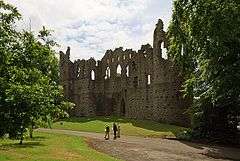The Jealous Wall
| The Jealous Wall | |
|---|---|
| An Balla Éad | |
 A view of the back of the wall, 2011 | |
| Alternative names | Jealousy Wall |
| General information | |
| Type | Folly |
| Architectural style | Gothic |
| Location | Belvedere House and Gardens |
| Town or city | Mullingar, County Westmeath |
| Country | Ireland |
| Coordinates | 53°28′34.698″N 7°22′6.632″W / 53.47630500°N 7.36850889°WCoordinates: 53°28′34.698″N 7°22′6.632″W / 53.47630500°N 7.36850889°W |
| Elevation | 103 metres (338 ft) |
| Named for | Robert Rochfort, 1st Earl of Belvedere's jealousy of his brother, George Rochfort's new house and his wife's popularity |
| Completed | 1760 |
| Owner |
|
| Technical details | |
| Material | Limestone |
The Jealous Wall is a large 18th century Gothic folly made from limestone located in the Belvedere House and Gardens in Mullingar, County Westmeath, Ireland. It is notable for being the largest folly in Ireland.[1]
History
The folly, also known as a sham ruin, was completed in c. 1760 by Robert Rochfort, 1st Earl of Belvedere due to many factors including his brother, George's new mansion, Tudenham Park House being better than his Belvedere House, and his jealousy of his wife, Mary Molesworth. Around 1742, Rochfort suspected his wife of adultery with Robert's brother, Arthur. She was imprisoned in their family home, Gainstown House with servants for over thirty years as Robert had lost his interest in her, and could not bear seeing her.[2] Whilst divorce proceedings were being prepared, Arthur had fled the country. He returned years later, which resulted in Robert bringing a case against him, and he died at Marshalsea debtors' prison as he was unable to repay his debt of £20,000.[3]
References
- ↑ "The Jealous Wall… Ireland's Largest Folly: Mullingar, Co. Westmeath | Ireland Travel Kit". www.irelandtravelkit.com. Retrieved 2017-06-19.
- ↑ "The-Jealousy-Wall". www.sexualfables.com. Retrieved 2017-06-19.
- ↑ "The Sordid Tale Behind the Jealous Wall". A Trip to Ireland. 2013-10-23. Retrieved 2017-06-19.